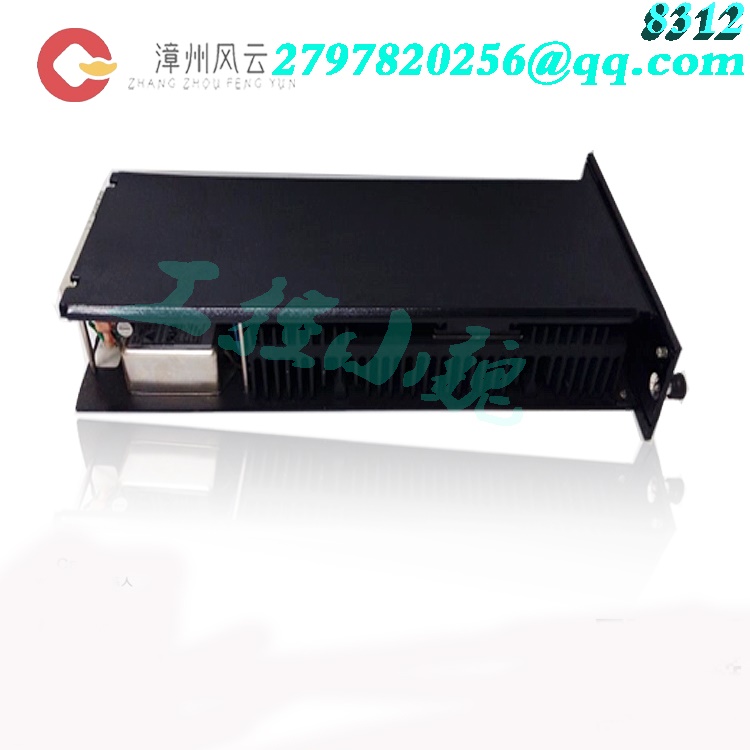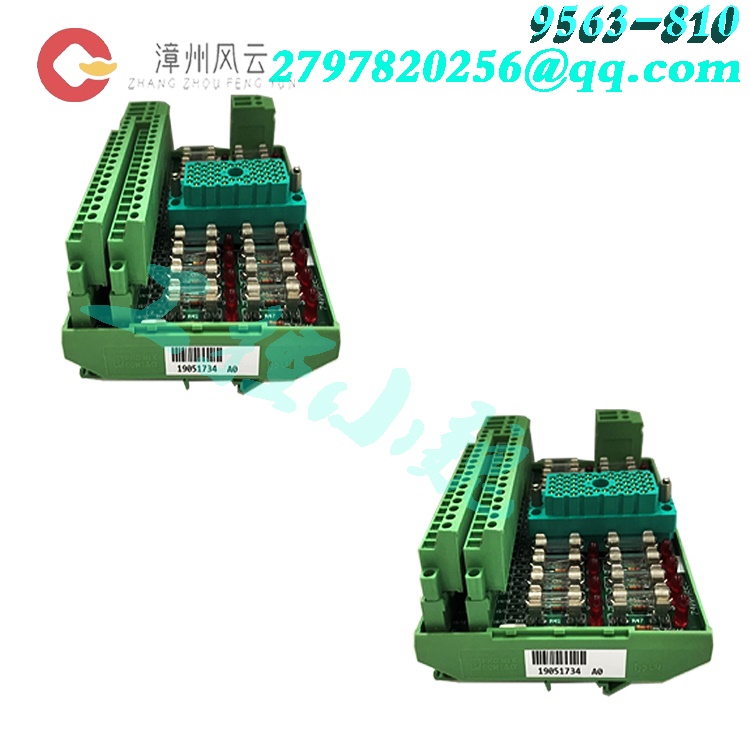TRICONEX-3351-Planning and Installation Guide, Trident v1.2
Date: Mar 21, 2025 Views: 4702
To ensure the highest possible system integrity at all times, the Trident controller includes the following features:
Provides Triple Modular Redundant (TMR) architecture, whereby each of three identical channels independently executes the application, and specialized hardware and software mechanisms vote all inputs and outputs.
Withstands harsh industrial environments.
Integrates the I⁄O module with the termination assembly.
Enables field installation and repair to be done at the module level while the controller remains online without disturbing field wiring.
Supports up to 14 I⁄O modules. (If the controller includes AO or PI Modules, up to 10 modules are supported.)
Provides TriStation and Modbus communication directly from the Main Processor (MP) or from the Communication Module (CM).
Executes applications developed and debugged using TriStation.

Provides a dedicated co-processor which controls the input and output modules to reduce the workload of the MP. Each I⁄O module is supported by custom application-specific integrated circuits (ASICs), which scan inputs and perform diagnostics to detect hardware faults. Output module ASICs do the following:
– Supply information for voting of output data.
– Check I⁄O loop-back data from the output terminal for final validation of the output state.
– Perform diagnostics to detect hardware and field-wiring problems.
Provides integral online diagnostics with adaptive-repair capabilities.
Allows normal maintenance while the controller is operating, without disturbing the controlled process.
Supports hot-spare I⁄O modules for critical applications for which prompt service may not be possible.
Provides integral support for redundant field and logic power sources.
Fault Tolerance
Fault tolerance, the most important capability of the controller, is the ability to detect transient and steady-state error conditions and take appropriate corrective action online. Fault tolerance provides an increase in safety and the availability of the controller and the process being controlled.
The Trident controller provides fault tolerance through TMR architecture. The controller consists of three identical channels (except for the power modules which are dual-redundant). Each channel independently executes an application in parallel with the other two channels. Voting mechanisms qualify and verify all digital inputs and outputs from the field; analog inputs are subject to a mid-value selection process.
Because each channel is isolated from the others, no single-point failure in any channel can pass to another. If a hardware failure occurs in one channel, the faulty channel is overridden by the other channels. Repair consists of removing and replacing the failed module in the faulty channel while the controller is online and without process interruption.

Extensive diagnostics on each channel, module, and functional circuit immediately detect and report operational faults by means of indicators or alarms. All diagnostic fault information is accessible by the application and the operator. The operator can use the diagnostic information to modify control actions or direct maintenance procedures.
Controller Architecture
The controller features TMR architecture to ensure fault tolerance and error-free, uninterrupted control in the event of hard failures of components or transient faults from internal or external sources.
Each I⁄O module houses the circuitry for three independent channels. Each channel on the input modules reads the process data and passes that information to its respective MP. The three MPs communicate with each other using a proprietary, high-speed bus called the TriBus.
Once per scan, the MPs synchronize and communicate with their neighbors over the TriBus. The TriBus forwards copies of all analog and digital input data to each MP and compares output data from each MP. The MPs vote the input data, execute the application, and send outputs generated by the application to the output modules. In addition, the controller votes the output data on the output modules as close to the field as possible to detect and compensate for any errors that could occur between the TriBus voting and the final output driven to the field.
For each I⁄O module, the controller can support an optional hot-spare module. If present, the hot-spare takes control if a fault is detected on the primary module during operation. The hot-spare position is also used for the online hot repair of a faulty I⁄O module.
Main Processor Architecture
A controller contains three MPs. Each MP controls a separate channel and operates in parallel with the other two MPs.
A dedicated I⁄O control processor on each MP manages the data exchanged between the MP and the I⁄O modules. A triplicated I⁄O bus, located on the baseplates, extends from one column of I⁄O modules to another column of I⁄O modules using I⁄O bus cables.
As each input module is polled, the appropriate channel of the I⁄O bus transmits new input data to its MP. The input data is assembled into a table in the MP and is stored in memory for use in the voting process.
The individual input table in each MP is transferred to its neighboring MP over the TriBus. After this transfer, voting takes place. The TriBus uses a programmable device with direct memory access to synchronize, transmit, and compare data among the three MPs.
If a disagreement occurs, the signal value found in two of three tables prevails, and the third table is corrected accordingly. One-time differences which result from sample timing variations are distinguished from a pattern of differing data. Each MP maintains data about necessary corrections in local memory. Any disparity is flagged and used at the end of the scan by the built-in fault analyzer routines to determine whether a fault exists on a particular module.
The MPs send corrected data to the application. The 32-bit MP executes the application in parallel with the neighboring MPs and generates a table of output values that are based on the table of input values according to user-defined rules.The I⁄O control processor on each MP manages the transmission of output data to the output modules by means of the I⁄O bus.
Using the table of output values, the I⁄O control processor generates smaller tables, each corresponding to an individual output module. Each small table is transmitted to the appropriate channel of the corresponding output module over the I⁄O bus. For example, MP A transmits the appropriate table to channel A of each output module over I⁄O bus A. The transmittal of output data has priority over the routine scanning of all I⁄O modules.
Each MP provides a 16-megabyte DRAM for the user-written application, sequence-of-events (SOE) and I⁄O data, diagnostics, and communication buffers. (For more information about SOE, see the Sequence of Events Recorder User's Manual.) The application is stored in flash EPROM and loaded in DRAM for execution. The MPs receive power from redundant 24 volts DC power sources. If an external power failure occurs, all critical retentive data is stored in NVRAM. A failure of one power source does not affect controller performance. If the controller loses power, the application and all critical data are retained indefinitely.
Bus and Power Distribution
The triplicated I⁄O bus, as shown on page 8, is carried baseplate-to-baseplate using Interconnect Assemblies, I⁄O Extender Modules, and I⁄O bus cables. The redundant logic power distribution system is carried using Interconnect Assemblies and I⁄O Extender modules.
The TriBus, which is local to the MP Baseplate, consists of three independent, serial links operating at 25 megabits per second. The TriBus synchronizes the MPs at the beginning of a scan. Then each MP sends its data to its upstream and downstream neighbors. The TriBus takes the following actions:
• Transfers input, diagnostic, and communication data
• Compares data and flags disagreements with the output of the previous scan and program memory
An important feature of the Trident controller architecture is the use of a single transmitter to send data to both the upstream and downstream MPs. This ensures that the same data is received by the upstream processor and the downstream processor.
Field signal distribution is local to each I⁄O baseplate. Each I⁄O module transfers signals to or from the field through its associated baseplate assembly. The two I⁄O module slots on the baseplate tie together as one logical slot. The right or left position holds the active I⁄O module and the other position holds the hot-spare I⁄O module. Each field connection on the baseplate extends to both active and hot-spare I⁄O modules. Consequently, both the active module and the hot-spare module receive the same information from the field termination wiring.
A triplicated I⁄O bus transfers data at 2 megabits per second between the I⁄O modules and the MP. The I⁄O bus is carried baseplate-to-baseplate and can be extended to multiple columns of I⁄O modules. Each channel of the I⁄O bus runs between one MP and the corresponding channel on the I⁄O module. The I⁄O bus extends between DIN rails using a set of three I⁄O bus cables.
Logic power for the modules on each DIN rail is distributed using two independent power rails. Each module along the DIN rail draws power from both power rails through redundant DC-DC power converters. Each channel is powered independently from these redundant power sources.
![]() Planning and Installation Guide, Trident v1.2.pdf
Planning and Installation Guide, Trident v1.2.pdf
Related product recommendations:
8311N
8310N2
8310
8120E
8112
8111
8110
9760-210
9853-610
9771-210
3401
3381
3351
3301
3201
3351
3009
3005
3006
3008
3008N
3002
More......
RELATED ARTICLE
Address
Room 205, Office Building, No.1 Chaoyang North Road, Longwen District, Zhangzhou City, Fujian Province
fengyunfadacai@qq.com
Sales consultant
Miss.Green
+86 15860249102
